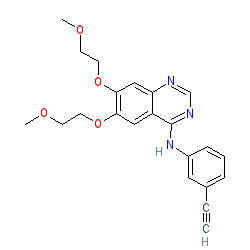GtoPdb is requesting financial support from commercial users. Please see our sustainability page for more information.
|
Synonyms: NSC 718781 | OSI 744 | OSI-774 | R 1415 | Tarceva®
erlotinib is an approved drug (FDA (2004), EMA (2005))
Compound class:
Synthetic organic
Comment: Erlotinib is a clinically approved type-1 inhibitor of the epidermal growth factor receptor (EGFR) receptor tyrosine kinase. This drug shows some selectivity for EGFR exon 19 deletion or exon 21 L858R mutations over the wild type receptor.
Subsequent studies have shown erlotinib to be a potent inhibitor of JAK2V617F activity. JAK2V617F, a mutant from of tyrosine kinase JAK2, is found in most patients with polycythemia vera (PV) and a substantial proportion of patients with idiopathic myelofibrosis or essential thrombocythemia. Study suggests that erlotinib may be used for treatment of JAK2V617F-positive PV and other myeloproliferative disorders. Specificity of inhibition with regard to other tyrosine kinase receptors remains to be fully characterized. Erlotinib is a Type-1 kinase inhibitor. Ligand Activity Visualisation ChartsThese are box plot that provide a unique visualisation, summarising all the activity data for a ligand taken from ChEMBL and GtoPdb across multiple targets and species. Click on a plot to see the median, interquartile range, low and high data points. A value of zero indicates that no data are available. A separate chart is created for each target, and where possible the algorithm tries to merge ChEMBL and GtoPdb targets by matching them on name and UniProt accession, for each available species. However, please note that inconsistency in naming of targets may lead to data for the same target being reported across multiple charts. ✖
View more information in the IUPHAR Pharmacology Education Project: erlotinib |
|
|||||||||||||||||||||||||||||||||||
| References |
|
1. Anastassiadis T, Deacon SW, Devarajan K, Ma H, Peterson JR. (2011)
Comprehensive assay of kinase catalytic activity reveals features of kinase inhibitor selectivity. Nat Biotechnol, 29 (11): 1039-45. [PMID:22037377] |
|
2. Davis MI, Hunt JP, Herrgard S, Ciceri P, Wodicka LM, Pallares G, Hocker M, Treiber DK, Zarrinkar PP. (2011)
Comprehensive analysis of kinase inhibitor selectivity. Nat Biotechnol, 29 (11): 1046-51. [PMID:22037378] |
|
3. Flockhart DA.
Drug Interactions: Cytochrome P450 Drug Interaction Table. Indiana University School of Medicine (2007). Accessed on 18/11/2014. Modified on 18/11/2014. http://medicine.iupui.edu/clinpharm/ddis/clinical-table/ |
|
4. Gao Y, Davies SP, Augustin M, Woodward A, Patel UA, Kovelman R, Harvey KJ. (2013)
A broad activity screen in support of a chemogenomic map for kinase signalling research and drug discovery. Biochem J, 451 (2): 313-28. [PMID:23398362] |
|
5. Karlgren M, Vildhede A, Norinder U, Wisniewski JR, Kimoto E, Lai Y, Haglund U, Artursson P. (2012)
Classification of inhibitors of hepatic organic anion transporting polypeptides (OATPs): influence of protein expression on drug-drug interactions. J Med Chem, 55 (10): 4740-63. [PMID:22541068] |
|
6. Wodicka LM, Ciceri P, Davis MI, Hunt JP, Floyd M, Salerno S, Hua XH, Ford JM, Armstrong RC, Zarrinkar PP et al.. (2010)
Activation state-dependent binding of small molecule kinase inhibitors: structural insights from biochemistry. Chem Biol, 17 (11): 1241-9. [PMID:21095574] |
|
7. Zhang YM, Cockerill S, Guntrip SB, Rusnak D, Smith K, Vanderwall D, Wood E, Lackey K. (2004)
Synthesis and SAR of potent EGFR/erbB2 dual inhibitors. Bioorg Med Chem Lett, 14 (1): 111-4. [PMID:14684309] |








